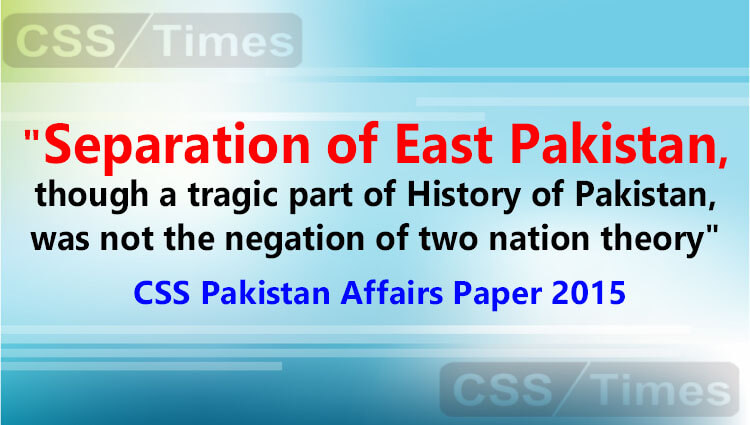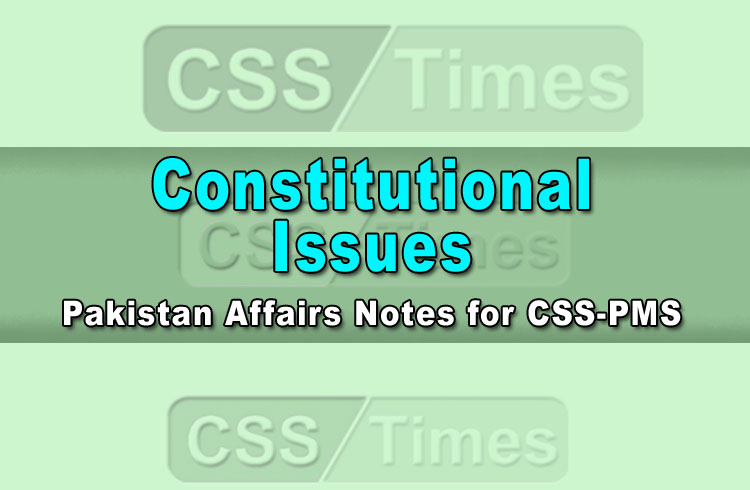Constitutional Issues | Pakistan Affairs Notes for CSS-PMS
Constitution is a set of basic principles and framework for governance and exercise of political power and legal authority. It clarifies the scope of power, relationship among various institutions within the government and society. It has precedence over ordinary laws and cannot be changed like ordinary laws. The Government of India Act (1935) was modified and promulgated in the newly state of Pakistan. The elected members in the 1946 elections made the first Constituent Assembly that faced grievous circumstances.
Major Issues
The major issues, the first constituent assembly faced, were about:
- Federalism
- Representation
- Separate or Joint Electorate
- The National Language Issue
- Parliamentary or Presidential system
- The Islamic or Secular State
1: Federalism
There was consensus on federalism but yet there were many issues to be settled. The main was that Pakistan consisted of two territorial parts, East Pakistan (with more population, less territory but administratively one unit) and West Pakistan (administratively 4 units). Federalism is meant to accommodate such kind of diversity maintaining the unity of the state or country.
Division of power:
It was the most difficult question that how the power would be divided between Centre and the Provinces. The heritage of British rule gave the tradition of a Strong Centre. But the provinces were demanding more Autonomy and Provincial Rights.
In the Interim Constitution and the 1956 Constitution tradition of strong centre continued.
2: Representation
Representation at the federal level was another conflicting issue because East Pakistan and West Pakistan were different in population and size. On the other hand there was diversity in Western part of Pakistan. The provinces of West Pakistan were also different in population and size. All of them were sensitive to their representation and provincial autonomy.
To have a Standard Formula for the representation of units and population the Constituent Assembly (CA) formed a Basic Principle Committee (BPC) on March 12, 1949. The primary task of this committee was to frame a set of basic principles for the future constitution of Pakistan.
First BPC Report:
This committee presented its first report on 28th September 1950. According to this report two houses of the parliament were proposed. The lower house was to be elected on the basis of POPULATION and the upper house was to be elected on the basis of equal representation for all the provinces of Pakistan namely East Bengal, West Punjab, Sindh, NWFP and Baluchistan.
Equal powers were proposed for the both Houses. No mention of National Language was made.
East Bengal opposed this report and Liaqat Ali Khan withdrew it.
Second BPC Report:
BPC presented its final report on 22nd December 1952. According to this report two Houses of the Parliament will enjoy the equal status and powers. It proposed equal representation to East and West wing.
This report also faced reaction in both the wings of Pakistan. The principle of parity was not appreciated in both East Pakistan and Punjab.
Muhammad Ali Bogra Formula:
Muhammad Ali Bogra immediately after assuming the office of the Prime Minister presented a formula to resolve the deadlock in constitution making. According to this formula Pakistan would have a bicameral legislature. In upper house there would be EQUAL representation to each of five units. In lower house population will be represented. In this way more representation was given to East Pakistan.
Both wings would have equal strength in joint sessions of the two houses.
Reaction to Bogra Formula
It was welcomed in both parts of the country. The principle of parity and representation of the population was appreciated. It also solved the problem of national language by suggesting Urdu and Bengali both as national language.
One Unit of West Pakistan October 1955
One Unit of West Pakistan was established on 14th October 1955. The provinces of Punjab, Sindh, NWFP and Baluchistan would be amalgamated in one unit to establish parity between the two parts of the country.
3: Separate or Joint Electorate
Separate electorate was adopted on the demand of Muslims in 1909 by the British Government. But the minorities did not favour this after independence. Religious elements supported this as a part of heritage.
East: decided for Joint Electorate. West: Separate electorate.
1957: Joint Electorate was adopted for all Pakistan by the National Assembly.
4: The National Language Issue
Pre-independence: Muslim elite all over India adopted Urdu. In 1948 Jinnah declared that Urdu would be the national language but provinces could use their languages.
Opposition against Urdu was there in East Bengal. This became more pronounced after the death of Jinnah as controversies erupted on constitution making. Language Movement started in East Pakistan February, 1952.
There was a complaint about anti Bengali language attitude of the federal government.
Two-language formula was adopted in 1954. Since 1973 Urdu was adopted as national language along with the support for development of regional languages.
5: Parliamentary or Presidential
There was a consensus for parliamentary system. But there was a limited demand for presidential system. Supporters of Presidential system became dominant after the 1958 military takeover. The 1962 Constitution was a Presidential constitution.
7: The Islamic or Secular State
From the very beginning of Pakistan Movement there was an agreement that the state will have close relationship with Islam. Muslims defined their national identity with reference to Islam and its heritage. Some opposition came from the Congress members of the Constituent Assembly, and a few secularists.
There was a BROAD AGREEMENT that the state will identify itself with Islam. The Constituent
Assembly took time to define the precise relationship between the state and Islam.
Objectives Resolution
As discussed in lecture 16 Objectives Resolution rejected theocracy in Pakistan and provided the basic objectives for the future constitution of Pakistan.
The issues to be addressed were:
1. Scope of legislation for an elected Assembly?
2. Who will decide about the Islamic nature of laws? Should a Board of Ulema be given this power?
3. Position of women, vote and work?
4. Religious minorities?
Discussion in the Constituent Assembly and outside continued. There was an active demand by religious elements for Islamic political system. In this context the leading Ulema of various sects presented famous 22 points to provide a religious base to the future constitution.
The Key Issue:
What kinds of institutions and processes have to be created to translate the notion of supremacy of the Qur’an and the Sunnah
• The Constituent Assembly adopted a middle course and a modernist perspective.
• Spirit of Islamic principles and values, modern notions of governance, representation and administration were amalgamated.
Islamic provisions would be taken up when we discuss the constitutions.
Courtesy: CSSForum
Check Other NOTES for Pakistan Affairs
[catlist name=”Pakistan Affairs Notes”]


